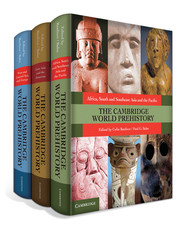Book contents
- Frontmatter
- Contents Summary for Volumes 1, 2 and 3
- Contents
- Volume 1 Maps
- Volume 2 Maps
- Volume 3 Maps
- About the Contributors
- Volume 1
- I. Introduction
- II. Africa
- 1.4 Early Hominins
- 1.5 Earliest Industries of Africa
- 1.6 The Human Revolution
- 1.7 The Genus Homo in Africa
- 1.8 Becoming Human: Archaeology of the Sub-Saharan Middle Stone Age
- 1.9 The Later Stone Age of Southern Africa
- 1.10 Prehistory in North Africa after the Middle Palaeolithic
- 1.11 Holocene Prehistory of West Africa
- 1.12 The Archaeology of the Central African Rainforest: Its Current State
- 1.13 The Later Prehistory of Southern Africa from the Early to the Late Iron Age
- 1.14 The Prehistory of East Africa
- 1.15 Neolithic and Predynastic Egypt
- 1.16 The Emergence of the Egyptian State
- 1.17 Pharaonic History
- 1.18 Summary of Classical and Post-Classical Africa
- 1.19 Africa: Languages
- III. South and Southeast Asia
- IV. The Pacific
- Volume 2
- Volume 3
- Index
- References
1.12 - The Archaeology of the Central African Rainforest: Its Current State
from II. - Africa
Published online by Cambridge University Press: 05 August 2014
- Frontmatter
- Contents Summary for Volumes 1, 2 and 3
- Contents
- Volume 1 Maps
- Volume 2 Maps
- Volume 3 Maps
- About the Contributors
- Volume 1
- I. Introduction
- II. Africa
- 1.4 Early Hominins
- 1.5 Earliest Industries of Africa
- 1.6 The Human Revolution
- 1.7 The Genus Homo in Africa
- 1.8 Becoming Human: Archaeology of the Sub-Saharan Middle Stone Age
- 1.9 The Later Stone Age of Southern Africa
- 1.10 Prehistory in North Africa after the Middle Palaeolithic
- 1.11 Holocene Prehistory of West Africa
- 1.12 The Archaeology of the Central African Rainforest: Its Current State
- 1.13 The Later Prehistory of Southern Africa from the Early to the Late Iron Age
- 1.14 The Prehistory of East Africa
- 1.15 Neolithic and Predynastic Egypt
- 1.16 The Emergence of the Egyptian State
- 1.17 Pharaonic History
- 1.18 Summary of Classical and Post-Classical Africa
- 1.19 Africa: Languages
- III. South and Southeast Asia
- IV. The Pacific
- Volume 2
- Volume 3
- Index
- References
Summary
Setting the Stage
It is the aim of this chapter to present an up-to-date review of the archaeology of the equatorial rainforest. Whenever necessary, it will reach beyond the forest to consider phenomena that might have been connected with its internal settlement history. Insofar as general stimuli and processes of a natural or cultural order are important to the settling of the forest by pottery-producing and farming people, we will even have to adopt a perspective that goes beyond Central Africa.
Although “Central Africa” represents primarily a geographical term, its current usage is fundamentally marked by political considerations even if there is no common understanding. For our purposes, the term comprises the following states, listed in clockwise order: Cameroon, the Central African Republic, the Democratic Republic of Congo (DRC, or Congo-Kinshasa, formerly Zaïre), the northern part of Angola, the Republic of Congo (Congo-Brazzaville), Gabon and Equatorial Guinea. In this conception, Central Africa covers the area between approximately latitude 11°N to 12°N and longitude 8° to 27°E. Other archaeologists, such as P. de Maret (2005), add the southern part of Chad as well as Rwanda and Burundi.
Topography, Climate and Vegetation
In some sense, Central Africa can be thought of as being grouped around the Congo Basin, which represents the largest depression of the continent. However, “depression” is a relative term, since it implies only that it is low lying in comparison to its surroundings. Thus, the Congo Basin shows an average height of about 400 m above sea level. Its inner plains, formed by ongoing accumulation and erosion during the Pliocene, Pleistocene and Holocene, are characterised by a gentle relief of roughly 20 to 40 m. Rivers, lakes and creeks as well as swamps and seasonally induced inundation zones are ubiquitous in such a way that the topography alternates between accompanying zones of low-lying land and more elevated surfaces.
- Type
- Chapter
- Information
- The Cambridge World Prehistory , pp. 183 - 203Publisher: Cambridge University PressPrint publication year: 2014
References
- 4
- Cited by

